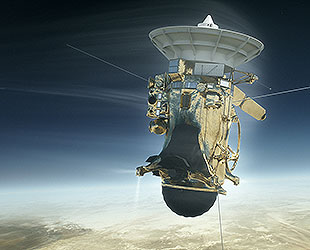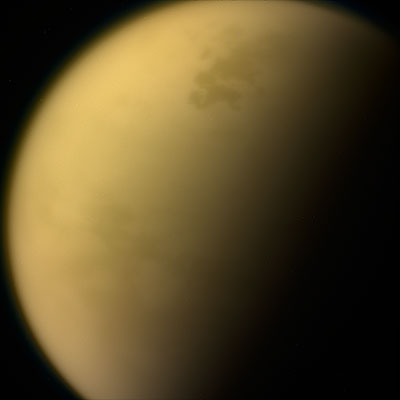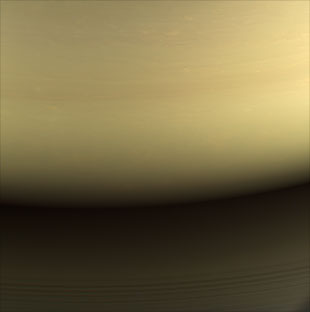September 15, 2017 — In the end, Cassini concluded its 13-year NASA mission orbiting Saturn in a meteoritic blaze that likely lasted less than two minutes.
Plunging into Saturn's upper atmosphere at 77,000 miles per hour (124,000 kp/h), Cassini, a bus-sized NASA probe, fired its thrusters to keep its high-gain antenna pointed at the Earth. Even at full capacity though, the small jets were no match for the atmospheric pressure at about 930 miles (1,500 km) above the planet's cloud tops, and the robotic spacecraft entered a tumble.
"It is going to very gradually drift off point and find a more stable aerodynamic altitude, which won't be pointing at the Earth," Earl Maize, Cassini's program manager at NASA's Jet Propulsion Laboratory (JPL) in Pasadena, Calif., said a day before the mission's end.
"The atmosphere [will] make Cassini more aerodynamic by stripping away parts," added Luis Andrade, guidance and control engineer for Cassini.
Its connection with Earth severed, there is no way to know for certain how the spacecraft met its end, but an analysis by the mission's engineers detailed how Cassini was likely to disintegrate.

Artist's rendering depicting the Cassini spacecraft during its initial plunge into Saturn's upper atmosphere. (NASA/JPL-Caltech) |
"The parts of the spacecraft that will be shielded away will last a little bit longer," Maize said. "A lot of the spacecraft is aluminum. It will melt very quickly. A lot of it is carbon fiber, mylar and things like that — and they are going to go very quickly."
Ultimately, Cassini was likely reduced to just the aeroshells protecting its plutonium power source, which were built to survive an accident and re-entry during the probe's launch from Earth 20 years ago on Oct. 15, 1997.
"So those will be the last pieces," said Maize.
Cassini's final signal was received on Earth by antennas in Canberra, Australia, at 4:55 a.m. PDT (1155 GMT) Friday (Sept. 15), but because it takes 83 minutes for radio waves to travel from Saturn, the spacecraft was already gone.
"The spacecraft's final signal will be like an echo," stated Maize. "It will radiate across the solar system for nearly an hour and a half after Cassini itself has gone."
Long-lived mission
Maize and his fellow team members, seated for the finale inside the mission control room at JPL, broke into a muted applause when the signal from Cassini dropped off. It was less an expression of celebration as it was a final salute to a long-lived mission.
"Maybe a trickle of telemetry left, but just heard the signal from the spacecraft is gone and within the next 45 seconds so will be the spacecraft," said Maize, addressing his team in the control center. "I hope you all are as deeply proud of this amazing accomplishment."
"Congratulations to you all," said Maize. "This has been an incredible mission, an incredible spacecraft and you are all an incredible team."
"I'm going to call this the end of mission. Project manager off the net."

Mosaic of Saturn assembled from raw images acquired by Cassini on Sept. 13, 2017, as it was on its way toward its plunge into the planet's atmosphere. Images were uncalibrated for color but were acquired in visible-light filters. (NASA/JPL-Caltech/SSI/Jason Major) |
Cassini was the first spacecraft to orbit Saturn and the most distant orbiter launched to date. It traveled 2.1 billion miles (3.4 billion km) to reach the ringed planet on July 1, 2004, and logged another 1.2 billion miles (1.9 million km) circling Saturn until its demise on Friday.
Over the course of its 13 years at the planet, Cassini took 453,048 images and sent back 635 gigabytes of science data. It discovered six named moons and made 162 flybys of Saturnian satellites, including 127 close encounters with Titan and 23 with Enceladus.
The mission carried the European Space Agency's (ESA) Huygens probe that landed on Titan in 2005 and together with Cassini's science instruments, revealed that the moon has methane lakes and Earth-like weather.
Even more surprising was Cassini's discovery of icy water plumes shooting off of Enceladus, a moon that is covered by an ocean with indications of hydrothermal activity.

Enhanced-color view of the Cassini spacecraft's final view of Titan obtained by the probe on Sept. 13, 2017. (NASA/JPL-Caltech) |
And then there were the findings about Saturn, itself.
"In particular, the interior of the planet is very different from what we expected," Linda Spilker, Cassini project scientist, said. "And its gravity field is not at all what we expected."
Further, Cassini's data showed that Saturn's rotation axis and magnetic field axis are almost perfectly aligned.
"Everything we think we know tells us that if you don't have at least a small tilt, you can't maintain those currents that sustain a magnetic field. So, we have some more thinking and some more work to do," said Spilker.
Grand finale
Cassini collected data about Saturn up until its very end.

A natural color view of the last image captured by NASA's Cassini spacecraft of Saturn's night side, as lit by reflected light from the rings, and showing the location where the probe would enter the planet's atmosphere hours later. (NASA/JPL-Caltech) |
In the day leading to the last of the probe's dives between Saturn and its rings, Cassini's camera was directed at the planet for a last look at features in the rings and the moons Titan and Enceladus. Without the data rate to send images during its final plunge, attention then turned to eight of the 12 science instruments on Cassini.
"This science is making Cassini Saturn's first atmospheric probe," said Spilker.
This last data may give scientists fundamental insights into Saturn's formation and evolution, as well as the processes that occur in the atmosphere.
"In its finale, Cassini has been giving scientists surprising new mysteries to be solved, the equivalent of gift-wrapped presents. The answer to some of these scientific puzzles may turn out to be some of the very best science of the mission," said Spilker.
